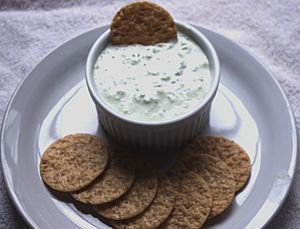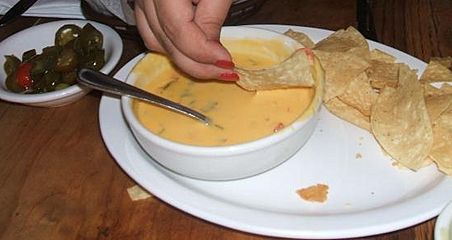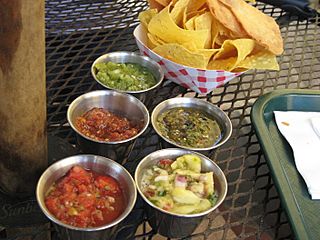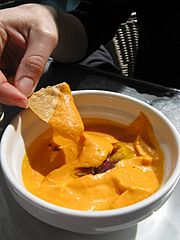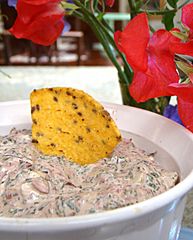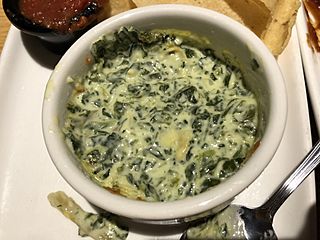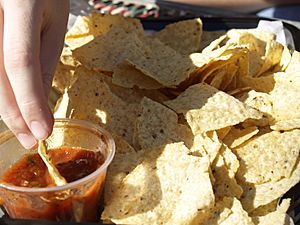Chips and dip facts for kids
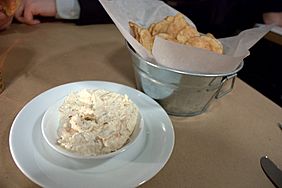
Chips and dip – crab dip and potato chips
|
|
| Type | Snack food |
|---|---|
| Course | Appetizer, side dish |
| Serving temperature | Dips can be cold or hot |
| Main ingredients | Various chips, crackers or crudites and dips |
| Similar dishes | Nachos |
Chips and dip is a popular snack or appetizer. It's a dish where you serve crunchy chips or crackers with a creamy or flavorful dip. You can use many kinds of chips, like potato chips, tortilla chips, corn chips, or even vegetable chips. Sometimes, people also use crackers or fresh, raw vegetables called crudités (like carrot sticks or celery). There are tons of different dips to choose from, each pairing well with different chips!
This snack became super popular in the United States in the 1950s. A big reason for this was a Lipton ad campaign. They promoted a simple recipe for French onion dip, sometimes called "California dip." People even started making special trays just for chips and dip! It's still a favorite, especially during big events like the Super Bowl football game. In the U.S., there's even a special day for it: National Chip and Dip Day on March 23.
Contents
How Chips and Dip Became Popular
Chips and dip really took off in the United States around 1954. This happened as people's ways of entertaining changed, especially in the suburbs. A big boost came from a Lipton advertising campaign.
The Famous California Dip
Lipton's ads showed how to make a dip using their instant dehydrated onion soup mix. You just mixed the soup powder with sour cream or cream cheese. This simple dip was served with potato chips or crudités. It quickly became known as California Dip. The ads were a huge success on TV and in stores. Soon, many similar dip products appeared.
During this time, new platters were designed. These platters had sections to hold different types of chips and a spot for the dip. Some people even served dip in a bread bowl or a hollowed-out fruit! Chips and dip are still a favorite food for the annual Super Bowl game. Did you know that 85% of Americans eat potato chips?
Chips with Corn-Based Snacks
Many popular chips and dip combinations use chips made from corn.
Popular Corn Chip Dips
- Chips and salsa are very common. They usually use tortilla or corn chips. This combo became super popular in the U.S. in the late 1980s.
- Chips and guacamole is another favorite, also often served with corn-based chips.
- Chips and bean dip is a tasty choice too.
- Seven-layer dip with tortilla chips is a fun, layered dip.
- Chile con queso is a melted cheese and chili pepper dip. It's often served in Tex-Mex restaurants with nachos.
- Dips with tortilla chips
-
A bowl of chile con queso served with tortilla chips as an appetizer in a Tex-Mex restaurant
-
Tortilla chips and several salsas
-
Salmorejo, a purée made mostly of tomato and bread, with a tortilla chip
What is Double-Dipping?
Double-dipping is when someone bites a chip, then dips it back into the shared dip. Some people don't like this, while others don't mind. The main concern is that double-dipping might transfer tiny bacteria from a person's mouth into the dip. These bacteria could then spread to others who eat the dip.
Surveys and Studies on Double-Dipping
In 2013, Tostitos, a brand of tortilla chips, did a survey about double-dipping. They asked over 1,000 Americans what they thought.
- 46% of men said they double-dip at parties, compared to 32% of women.
- 54% of people said they wouldn't eat dip after seeing someone double-dip.
- 22% said they didn't care.
- 25% said they would tell someone off for double-dipping.
A study at Clemson University looked into this. They suggested that just three to six double-dips could transfer about 10,000 bacteria from a person's mouth to the dip. This means about 50-100 bacteria could go from one mouth to another with each bite. The study suggested it's best to avoid double-dipping.
The TV show MythBusters also tested double-dipping in 2009. They found that some microbes (tiny living things) do transfer. However, they concluded that it "adds only a few more microbes" to the dip.
National Chip and Dip Day
National Chip and Dip Day is celebrated every year in the United States on March 23. In 2015, the Tostitos brand celebrated this day. They gave out coupons for free dip to customers named "Chip." It's a fun day to enjoy this classic snack!


